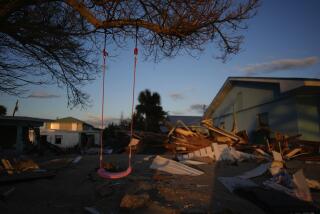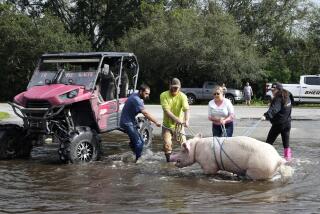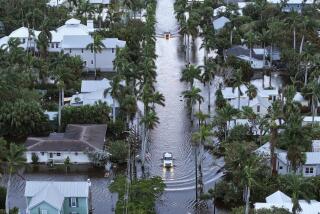Troops Flood Florida to Assist in Hurricane Relief Effort : Military: Soldiers assess urgent local needs and notify victims of food distribution points. They erect tent cities and ready schools for reopening.
- Share via
WASHINGTON — American combat and support troops on Tuesday stormed Florida neighborhoods ravaged by Hurricane Andrew, beginning the installation of a structure for the delivery of disaster relief that one senior military officer predicted could become “truly a long-term operation” of recovery.
“The object of the exercise is to put a military structure right down into the neighborhoods,” said Gen. Gordon Sullivan, the Army chief of staff who is overseeing the effort. “It became apparent that what we needed to do was put young leaders out there with their vehicles, their equipment, working with people in their neighborhoods with a chain of command that would come right back up to the community and county leadership.”
Sullivan said a total of 25,000 active-duty troops probably would be dispatched to the area, using two depots of the Miami International Airport as their operational hub. By Tuesday night, as many as 12,500 such troops--including public health and medical specialists, communications operators and combat and construction engineers--were to have arrived in the area, Sullivan added.
While Sullivan called the effort “civil-military cooperation at its best,” the operations he described suggested that the U.S. military, on White House orders, has moved forcefully to take control of the chaotic situation in southern Florida. The growing involvement of the military in Florida--coming on the heels of troop deployments to riot-torn Los Angeles--appears to mark an unusual escalation of the use of U.S. active-duty troops in domestic crises.
Military leaders traditionally have been wary of commitments that enmesh such troops in domestic crises. Sullivan said Army leaders were “very sensitive” to the legal limits restricting the role of U.S. forces in Florida. But he embraced the military’s latest mission as one for which U.S. troops are well-prepared.
In addition to erecting tent cities and readying schools for reopening, troops began broadcasting radio programs and distributing leaflets and battery-operated radios to residents of the affected areas. Sullivan added that they have also begun to assess urgent local needs and award contracts for the clearing of debris as well as the reconstruction of federal buildings.
“The concept is that those captains and lieutenant colonels will go out into the community and begin getting their arms around people in the areas where they are living,” said Sullivan, saying those officers could then ask for additional assistance.
The military effort has brought some of the active-duty military’s most elite troops--those of the quick-reaction 18th Airborne Corps--to South Florida. Commanders from the Army’s 10th Mountain Division, based at Ft. Drum, N.Y., as well as a brigade of combat troops from the 82nd Airborne Division based in Ft. Bragg, N.C., have been assigned to lead the relief and recovery operation.
Sullivan said the Commanding General of the 10th Mountain Division, Maj. Gen. Steve Arnold, “is actually sitting in the mayor’s office of Homestead right next to the city manager.” Pentagon spokesman Bob Hall later explained that the mayor remains in office as well. “They’re co-located in the same building, probably on the same floor and in the same suite,” said Hall.
Sullivan added that Homestead’s city manager will “have access” to special military transmitters flown in and currently broadcasting information in Spanish, English and Creole. Military vehicles armed with loudspeakers fanned out across the stricken area, broadcasting food distribution points and information on the availability of temporary housing in what Sullivan called an effort to “re-energize the structure.”
Sullivan said it is too early to predict how soon the active-duty military’s involvement would end. He cautioned, however, that such forces would mainly be involved in relief and recovery operations, but not in reconstruction of public structures or uninsured private dwellings. That, he said, would be managed by other federal agencies.
There were these other developments Tuesday:
* Disagreements emerged on the number of destroyed homes. Tom Herndon, Gov. Lawton Chiles’ chief of staff, said that 6,000 to 10,000 homes are now estimated destroyed; an estimated 25,000 suffered major damage and not all of them may be repairable; and an additional 45,000 to 50,000 have damage that can be repaired. Dade County officials continued to insist that an estimated 63,000 were destroyed.
* Two banks set up five temporary teller locations in the storm area, giving residents their first chance to get cash in a week.
* State offices began distributing an additional $127 million in food stamps as crowds of people formed long, sometimes angry, lines to get aid. One woman gave birth while waiting.
* Although military personnel have erected three tent cities, officials said it could be today before people are allowed to move in. Mud and rock slowed efforts to drive tent stakes.
* More than 480,000 people remained without electricity, and some customers will have to wait until the end of the month before service is restored.
The Associated Press contributed to this report.
RELATED STORY: D1
More to Read
Sign up for Essential California
The most important California stories and recommendations in your inbox every morning.
You may occasionally receive promotional content from the Los Angeles Times.











